COPD is a disease usually associated with smokers, which makes sense when smoking is the cause of approximately eighty to ninety percent of COPD cases. However, smoking is certainly not the only way you can get COPD, and there are many other lesser-known causes.
Being exposed to just about any kind of respiratory irritant over long periods of time can cause you to develop COPD. Things like dust, smog, mold, fine airborne particles, and toxic gases can result in serious lung and airway inflammation that, over the years, can cause COPD.
People who suffer from certain diseases, such as asthma and alpha-1 antitrypsin deficiency, also have a greater risk of developing COPD. These diseases have the potential to cause permanent damage to your lungs, leading to breathing problems later in life.
Even if you develop COPD related to smoking, it is possible that smoking is not the sole cause. If you suffer from asthma, have a history of frequent respiratory infections, or had frequent exposure to other respiratory irritants, these factors could combine with the damage caused by smoking and result in COPD.
It's important to know that COPD has many different causes, and that not everyone who develops COPD is a current or former smoker. The risks of pollution, dust, and other respiratory irritants are very real, and they can cause people who have never smoked or touched tobacco to develop the disease.
If more people are informed about the non-smoking causes of COPD, then more people will have the knowledge they need to protect their lungs from respiratory irritants and make lung-healthy choices throughout their lives. This could not only prevent thousands of new cases of COPD, but could also foster more understanding and compassion for those who already suffer from the disease.
Characteristics that Raise Your Risk for COPD

One of the first things that crosses many people's minds when they get a COPD diagnosis is, “how did this happen?” or “why did this happen to me?” While you may not ever be able to answer that question definitively, understanding all the potential causes may help give you some insight and closure.
Aside from the diseases and respiratory irritants we've mentioned, there are other factors that can put you at risk for COPD. For a variety of different reasons, things like your age, sex, medical history, genetics, and other personal characteristics can increase your likelihood of developing COPD.
While these things may raise your risk of sustaining lung damage and developing COPD later in life, these are usually not direct causes of COPD. These factors in combination with exposure to other COPD causes (such as smoking or exposure to toxic gases) is what ultimately causes you to get COPD.
If you or a loved one is already suffering from COPD, then understanding the causes of the disease can help you prevent the existing COPD from getting worse. If you are lucky enough to be untouched by COPD, then knowing the causes can help you avoid taking risks that increase your chances for developing the disease.
COPD Results from Cumulative Lung Damage Over a Lifetime

There are many different causes of COPD, and many of them are preventable. That's why it's important to understand what they are and what you can do to avoid them.
But first, it's important to understand that COPD is caused by repeated, long-term exposure to things that irritate and damage your lungs. These irritants can be things like smoke, chemical fumes, and even simply dust, but what causes COPD is accumulated damage over time.
That's why there is often not just one culprit, but a collection of potential causes that leads someone to develop COPD. Because of this, preventing COPD is a matter of making hundreds or thousands of small, healthy choices and making an effort to avoid harmful substances throughout a lifetime.
For instance, sitting around a campfire on occasional camping trips is very unlikely to cause long-term damage to your lungs. However, sitting around a campfire every night for months at a time, or working a job that requires you to be around a fire for hours a day, could cause permanent lung damage and significantly raise your risk for developing COPD later in life.

In the following sections, we're going to take a closer look at some of the most common non-smoking causes of COPD. We'll cover everything from toxic substances and respiratory irritants to diseases that are known to damage your lungs and cause COPD.
As you read through these next sections, remember that a single exposure or even years of exposure to any of the risk factors below does not mean that you will develop COPD. It goes the other way, too; if you have COPD, the fact that you were exposed to one of these risk factors does not necessarily mean that it is what caused your disease.
COPD is a complex disease that is difficult to diagnose and it is often difficult to find the root cause of specific cases. The causes listed below are not definitive triggers for COPD, but rather risk factors that increase your likelihood for developing COPD in the future.
Causes of COPD: Exposure to Air Pollution

In the modern age, pollution is everywhere; it comes from your car, local businesses, industrial activity, and even appliances in your home. We all know that air pollution is unhealthy, but many people underestimate the damage it can do to your lungs.
What we usually think of as “air pollution” or “smog” is actually a mixture of a variety of harmful gases and particles that irritate your lungs when you breathe them in. These pollutants can destroy healthy lung tissue, cause chronic respiratory problems, and cause you to develop COPD over time.
Studies show that these environmental and indoor pollutants can cause serious damage and may play a larger role in COPD than previously thought. That's why it's important to know the common sources of air pollution and how to keep your lungs safe.
Local Air Quality
.jpg?width=512&name=smog-and-electric-lines(1).jpg)
When most people think of air pollution, the first thing they think of is smog, or the smoky haze that often fills dense cities and industrial areas. While everyone knows that air pollution is bad for your health, many people underestimate the damage that breathing polluted air can have on your lungs over a lifetime.
Smog is made up of harmful gases and tiny airborne particles that get lodged deep in your lungs when you breathe. Over time, this can cause serious respiratory symptoms and permanent lung damage that results in COPD.
Here is an overview of some of the major respiratory irritants found in smog:
- Ozone gas
- Tiny airborne particles (from dust, smoke, and other sources)
- Volatile organic compounds (VOC's)
- Nitrogen oxides
- Sulphur dioxide
One of the most dangerous pollutants is ozone, which is created when fumes from cars, factories, and other sources react with sunlight in the earth's atmosphere. The ozone that forms then sinks to the ground, sometimes miles away from the original source of pollution.
Ozone is a very reactive, volatile gas that “aggressively attacks” healthy tissue when it enters your lungs. Even relatively small amounts of ozone can be dangerous, raising your risk of heart disease, stroke, and respiratory disorders like COPD.
People who live in areas like big cities that have poor outdoor air quality have a significant higher risk of COPD, lung cancer, and other respiratory disorders as a result. However, your local air quality is affected by a variety of different factors, including temperature and humidity, and it may vary significantly from day to day.
Smog is most common in urban areas with lots of traffic, commercial activity, or industrial pollution. However, things like forest fires and weather patterns can spread polluted air far away from its source.
To protect yourself from poor outdoor air quality, make sure you check your local air quality forecast on a regular basis, especially before spending an extended period of time outside. On days when pollution is high, try not to plan any outdoor activities, and close up your house to prevent your indoor air from becoming polluted as well.
For more tips on how to avoid the harmful gases and particles that pollute the air outdoors, check out our comprehensive guide on protecting your lungs from air pollution and smog.
Indoor Air Pollution

There are many different ways that the air in your home can get polluted, and most of them are avoidable. Things like smoke, particle pollution, and allergens like mold and pollen can all build up in your house and irritate your lungs when you spend time indoors.
Indoor pollution is an especially dangerous form of pollution because it collects in such a confined place and you get exposed to it for so many hours a day. If there are are any significant sources of pollution in your home, it can lead to serious lung damage and other health problems over time.
Appliances like stoves, gas-powered appliances, and fireplaces can also pose a problem if they aren't properly installed and maintained. That's why it's important to inspect your appliances regularly for malfunctions or improper venting and get them repaired promptly whenever you notice a problem.
It's also important to install enough smoke detectors and carbon monoxide detectors to detect harmful gases and smoke in every space in your house. To ensure your home is protected, it's important to keep them in good repair, which includes checking their batteries occasionally to make sure they still have charge.
The simplest ways to make sure your indoor air is healthy to breathe is to make sure your home is well-ventilated and free from mold, allergens, airway-irritating chemicals, and all forms of smoke. It's also important to keep all of your appliances maintained and avoid using fireplaces and wood-burning stoves as much as possible.
Here are some of the most common sources of indoor air pollution you should look out for:
- Stoves, heaters, fireplaces, and furnaces
- Small particulate matter (from dust and other sources)
- Secondhand smoke
- Carbon monoxide
- Allergens like pollen, dust mites, pet dander, bacteria, and mold
- Asbestos
- Radon
- Pesticides
For more practical tips, check out our comprehensive guide on how to improve the air quality in your home.
Wood-burning Stoves and Combustion Fumes

Using a wood-burning stove, fireplace, or furnace to heat your house is extremely risky because of the harm it can do to your lungs. Even when they are properly installed and vented, these appliances can still release harmful amounts of toxic chemicals and respiratory irritants into your home.
Wood smoke contains tiny particles that inflame your lungs when you breathe them in, which can lead to lung cancer and other breathing disorders like COPD with repeated exposure. Burning wood also releases toxic gases like carbon monoxide, nitrogen oxides, hydrocarbons, volatile organic compounds, formaldehyde, dioxins, acrolein, and more—all of which can damage your lungs and hurt your overall health.
Other common and oft-overlooked sources of combustion fumes include bonfires, fire pits, and BBQ grills. While these can be dangerous over a long period of time, you are unlikely to experience any long-term health effects from normal exposure; you are most at risk for COPD if you work around bonfires or grills for a living.

Burning wood or coal to heat your home is particularly dangerous because the fumes are contained indoors and present all day every day for extended periods of time. People who use a fireplace too often or rely on a wood-burning stove for heat are at serious risk for permanent lung damage and getting COPD later in life.
If you use a stove to heat your home, consider switching to a conventional gas or electric heating system for your house. If you do not have that option, there are special precautions you can take in order to reduce the amount of pollution that your stove leaks into your home.
Here are some tips to help you make your wood-burning stove more safe:
- Use an EPA-certified wood-burning stove, furnace, or fireplace insert to reduce the amount of harmful fumes. This could reduce the pollution released into the air by up to 90% and make your wood go further, too. Check out this guide from the EPA's website to learn more about how to find a safer appliance for burning wood.
- Always use firewood that has been properly dried and seasoned because it produces much less smoke than wet wood. To be extra safe, you can check your wood by using a moisture meter, which you can find online or at some hardware and woodworking stores.
- Always burn hardwoods instead of softwoods because they produce less smoke, burn slower, and make better firewood overall. To learn more about how to identify good firewood and soft versus hard types of wood, check out this helpful guide.
- Never burn wood that has been exposed to salt water or has been painted, processed, or treated with chemicals. That includes plywood, particle board, varnished wood, and trees exposed to pesticides.
- Get your chimney, stove, and ventilation system inspected every year for build-up, leaks, and other problems. A blocked up chimney will cause more smoke to leak into your home and can even cause deadly fires and carbon monoxide poisoning.
- Don't use your wood-burning stove or furnace any longer than you need to. Turn it off when it is warm enough and do your best to keep your home insulated so you don't have to use it any more than necessary.
- Always make sure you have working smoke and carbon monoxide detectors installed all throughout your home. Always replace the batteries immediately when they go out and check them a couple times a year to ensure that they are functioning.
Even if you use an EPA-certified stove and follow all of the recommendations above, you could still be putting yourself and your family's health at risk by burning wood or coal in your home. For more information about the dangers of wood smoke, you can check out the Families for Clean Air website or this fantastic guide from the state of Washington's Department of Ecology.
Radon
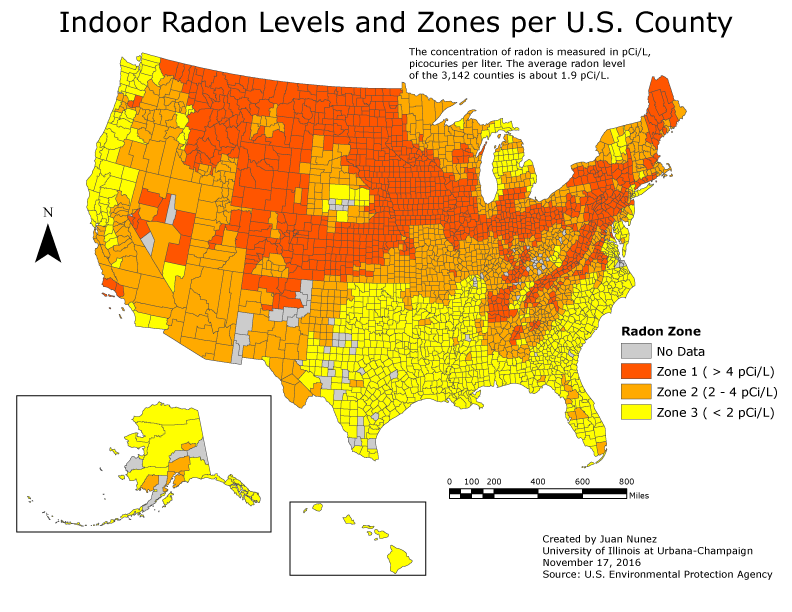
Radon is a toxic, radioactive gas that seeps out of the ground and can be harmful to your lungs in large amounts. Because the gas is invisible and has no smell, the only way to detect it is to use a special radon detector.
Radon gas is most often associated with lung cancer, as it is the most frequent cause of lung cancer among people who don't smoke. However, many people don't realize that radon exposure can also damage the air sacs in your lungs, which can lead to respiratory problems and breathing disorders like COPD.
Children are more sensitive to radon than adults, even though the effects don't show up until much later in life. Smokers' lungs are also particularly sensitive to the damaging effects of radon, and a smoker's risk for lung cancer and COPD will be much higher than a non-smoker who is exposed to the same levels of radon gas.
Radon can be found anywhere, although levels vary significantly from place to place. Most people are exposed to radon when it leaks into their homes from the surrounding earth through their foundation or water pipes.
The best way to protect yourself from this toxic gas is to buy a radon testing kit or have a licensed radon inspector come to your home. It is also important to keep your home well-ventilated so that radon and other pollutants don't have a chance to build up to harmful levels indoors.
Because radon levels can fluctuate significantly over time in reaction to weather, seasons, and changes in the ground. Because of this, you have to monitor radon levels over several months or years in order to get an accurate picture of how much radon gas you get exposed to in your home.
Causes of COPD: Exposure to Dust, Chemicals, and Fumes
Besides common air pollutants, there are a variety of other substances that can irritate and damage your lungs. Things like cleaning chemicals, dust, and exhaust fumes can all cause COPD if you're exposed to them too often over a lifetime.
Workplace Exposure
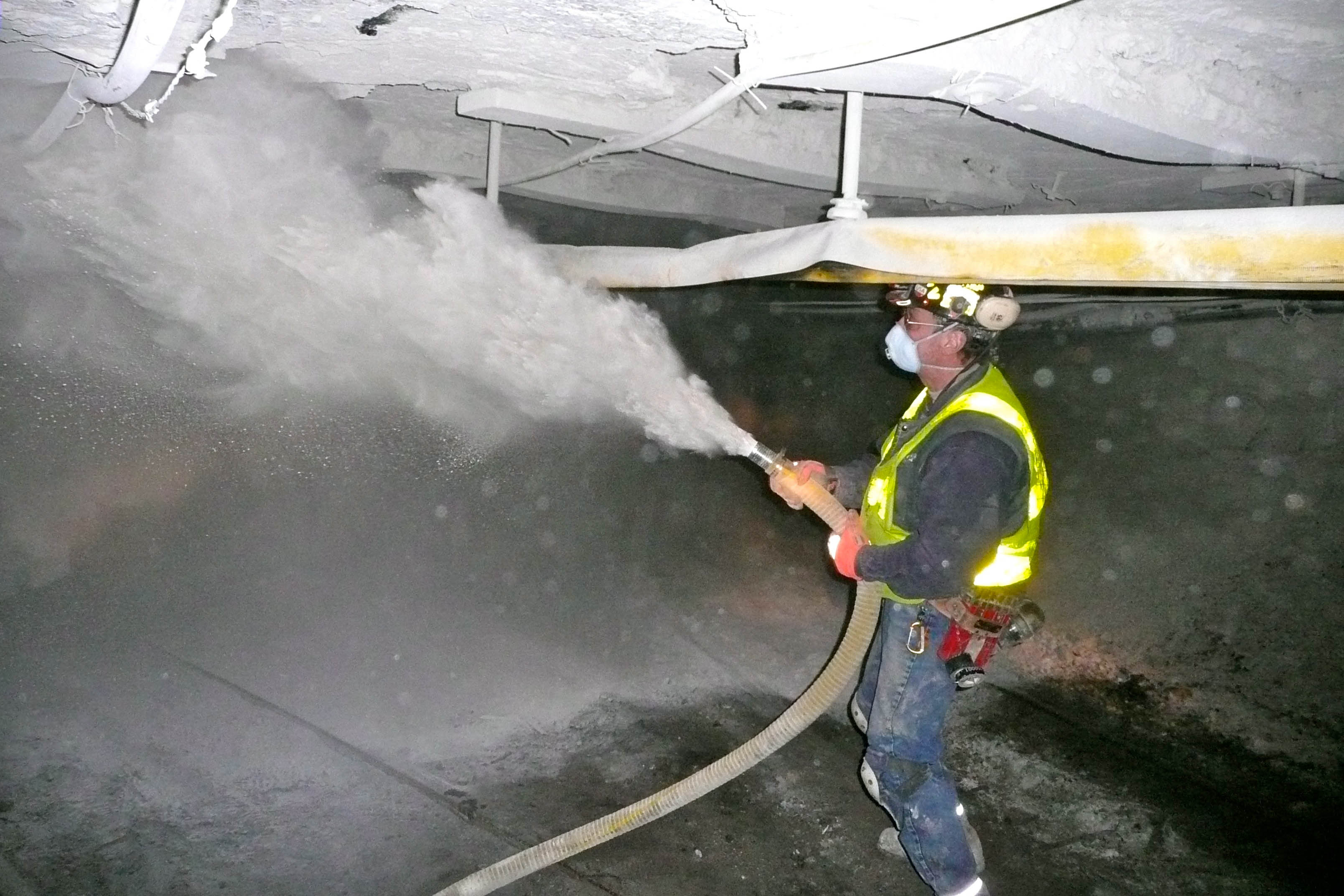
There are many different jobs and occupations that can expose you to toxic chemicals, dust, and fumes that cause COPD. Because your job requires you to be around these harmful substances for dozens of hours a week, occupational exposure poses a substantially higher risk to your health than other forms of exposure.
Any job that exposes you to fine particles or noxious chemicals can put you at risk for COPD. Certain types of dust, including silica dust, mineral dust, coal ash, and dust from flour and grains are particularly dangerous for your lungs.
Here is a list of some of the harmful dusts and fumes found in workplaces that can do permanent damage to your lungs:
- Cadmium Dust
- Mineral Dust
- Silica Dust
- Organic Dusts
- Grain and Flour Dusts
- Cadmium Fumes
- Welding Fumes
- Petroleum and Diesel Exhaust Fumes
- Pesticides and Herbicides
Many of theses dusts and fumes come from vehicles, machinery, mining, materials, and manufacturing processes. Working in versatile fields like construction, manufacturing, and agriculture may expose you to several of these lung-irritant sources on a regular basis.
If you work in a high-risk occupation, you should take extra safety measures to protect your lungs. Make sure your workplace follows all the guidelines and requirements from the Occupational Safety and Health Administration (OSHA) and wear a dust mask or respirator around dust and machine fumes.

Even if you don't develop COPD, occupational exposure to lung irritants can cause a variety of other health problems. It may raise your risk for lung cancer, breathing problems, occupational asthma, and respiratory infections like pneumonia.
Here is a list of occupations that put you most at risk for COPD:
- Mining Workers
- Agriculture Workers
- Quarry Workers
- Brick-making
- Stonemasonry
- Rubber and Plastics Manufacturing
- Petroleum Workers
- Foundry Workers
- Dock Workers
- Cadmium Workers
- Welders
- Textile Workers
- Pottery and Ceramics Workers
- Construction Workers
- Railroad Workers
- Engineers
- Auto Workers
- People who work with pesticides and herbicides
Exhaust Fumes

Fumes from car exhaust and machinery can damage your lungs over time, raising your risk for developing respiratory disorders like COPD. That's why people who live and work around busy roads, vehicles, and diesel exhaust for long periods of time are more likely to get the disease.
To reduce your exposure to car exhaust fumes on the road, close your windows when you drive on busy roads and set your car's ventilation to re-circulate the air in the cabin instead of pulling in air off the street. It's also a good idea to limit time spent near industrial parks and dense, urban areas when traffic is high.
Cooking Fumes

When you cook over a stove, the food you cook releases fumes into the air that can harm your lungs if you breathe them in. Because of this, frequent cooking throughout a lifetime can raise your risk of developing COPD.
Cooking fumes contain toxic chemicals like aldehydes and and alkanoic acids as well as carcinogens known to cause respiratory cancers. Even just breathing in fine particles or aerosolized oils that get released into the air when you cook can irritate your airways and lead to breathing disorders like COPD.
One study that looked at lifelong exposure to cooking found that women who cooked more often were up to four times more likely to develop COPD. The risk was higher for those who cooked in especially smoky kitchens, which are likely to have higher concentrations of oils and other harmful particles in the air.
Studies also show that cooking with a gas stove is riskier than an electric stove, and that deep frying foods and cooking foods at very high heats are more dangerous than other forms of cooking.

People who work in commercial kitchens are the most at risk for developing health problems like COPD from the fumes, but you should still exercise caution when you cook meals at home. Avoid breathing in fumes as much as possible and make sure your kitchen is well-ventilated.
Here are some more tips for reducing your exposure to cooking fumes that can cause COPD:
- Make sure your oven and stovetop are properly vented. If you cook often, you might want to consider investing in a separate exhaust fan or electric chimney for your kitchen.
- Open a window when you cook oily foods or you notice a strong smell or haze of cooking fumes.
- Use a portable air purifier to filter oils and other fine particles out of the air in your kitchen when you cook.
- Run your AC or HVAC fan while you cook to help ventilate your home.
- If possible, cook using electric heat instead of gas heat.
- Avoid frying large amounts of oil or extremely oily foods (such as bacon) in a frying pan to protect your lungs from ultrafine fat particles.
- Reduce the amount of cooking fumes you're exposed to every week by replacing some stovetop meals with dishes that you can cook inside the oven. Casseroles, pasta bakes, and broiled veggies and potatoes are great places to start.
Chemicals and Cleaning Products
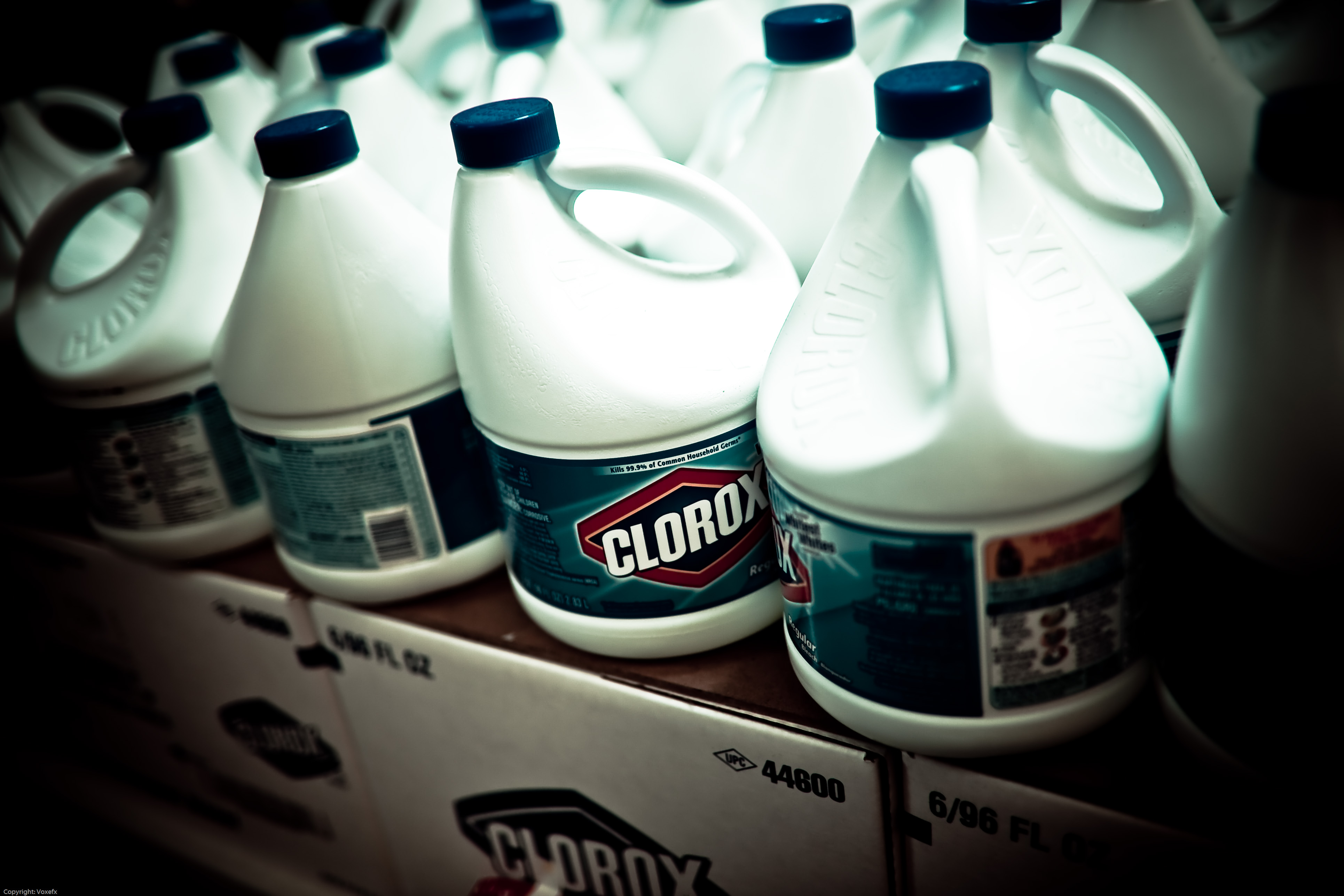
Household chemicals like bleach and other cleaning products can irritate and inflame your lungs. Over a lifetime, using these chemicals without taking the proper precautions can cause you to develop COPD.
Many everyday cleaning chemicals contain a variety of noxious fumes, including ammonia, bleach and volatile organic compounds (VOC's) like acetone, benzene, and formaldehyde. As we discussed before, VOCs are often found in smog and other forms of air pollution that can irritate and damage your lungs.
Even fragrances like citrus or other perfumes in cleaning products can put your lungs at risk. While they might have a pleasant smell, they can make the solution even more irritating and damaging to your lungs.
Studies show that cleaning with noxious chemicals even just once a week may increase your risk for COPD by up to 22 percent. To keep your lungs healthy when you clean, it's best to use mild, unscented cleaning products and make sure the room is well-ventilated while you clean.
You should also avoid using chemical cleaners when more simple solutions like a damp cloth or soap will do the trick. When you do clean, try to use allergy and lung-friendly products with fewer fragrances and volatile chemicals.
You should also avoid using pesticides and herbicides in your home unless strictly necessary, as long-term exposure to these chemicals is linked to asthma and COPD. Instead, try natural pest-control methods first, including deep-cleaning your home and using non-chemical, “mechanical” insect killers like traps or diatomaceous earth.
Here is a list of some of the most dangerous chemicals and cleaners you should avoid as much as possible:
- Any aerosol sprays containing chemicals and fragrances (air fresheners, perfumes, and cleaning products)
- Chlorine bleach
- Ammonia
- Dry cleaning chemicals
- Rug and upholstry cleaners
- Oven cleaners
- Furniture polish, floor polish, and varnishes
- Paints and paint removers
- Pesticides and fungicides
- Cleaning products containing bleach, ammonia, and VOCs
Secondhand Smoke

Even if you have never smoked a cigarette, long-term exposure to other people's secondhand smoke might still cause you to get COPD. In fact, studies show that people who are exposed to secondhand smoke may be twice as likely to develop COPD later in life.
You are most at risk if you were exposed during childhood or if you spend many hours every week around smoke. Secondhand smoke and COPD also have a dose-response relationship, which means that the longer and more often you get exposed, the higher your risk for COPD will be.
Besides COPD, secondhand smoke exposure can cause other diseases like lung cancer, heart disease, and asthma. That's why it's so important not to smoke indoors, around children, or other people who do not smoke.
To protect yourself and your loved ones from secondhand smoke, politely ask other smokers not to smoke near you or your family. Any time you notice the smell of tobacco smoke, try to distance yourself from the source, and avoid going to restaurants and and other public places that allow smoking.
Causes of COPD: Medical Conditions
Now that you understand the role that air pollution and respiratory irritants play in the development of COPD, let's take a look at the last major cause of the disease: medical conditions. Although they are somewhat rare, many cases of COPD can be traced back to medical causes like asthma, childhood infections, or a rare genetic disease known as Alpha-1 Antitrypsin Deficiency.
Severe Asthma
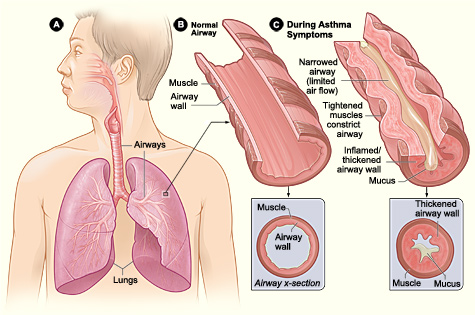
If you suffer from asthma, you may be more likely to develop COPD later in life, especially if you also smoke. In fact, studies show people with asthma may be up to 12 times more likely to get COPD.
This happens because asthma symptoms, especially severe asthma attacks, can cause serious airway inflammation and obstruct your ability to breathe. Although researchers are not entirely sure how asthma develops into COPD, they believe that these repeated episodes of bronchitis and chronic lung inflammation leave people with asthma more susceptible to long-term lung damage and COPD.
If you suffer from asthma, you can reduce your risk for COPD by being particularly careful to avoid respiratory irritants and keep your lungs healthy throughout your life. It's also important to treat your asthma effectively and reduce your symptoms as much as possible by always taking your medications and following your doctor's advice.
Frequent Respiratory Infections

Frequent resperatory infections can inflame and damage your lungs in a similar way to severe asthma. However, just one or more serious respiratory infections like pneumonia can raise your risk for COPD if they happen in early childhood.
In fact, one study found that people who have had pneumonia, bronchitis, or asthma early in life were more than 50% more likely to die of a respiratory disease. They were also nearly 40% more likely to die of cardiovascular disease and suffer from uncomfortable respiratory symptoms and respiratory decline later in life.
The best way to avoid respiratory infections is to practice good hygeine and keep up with your vaccinations. That includes getting vaccinated against the flu, which can protect you from serious lung complications like pneumonia.
If you do get sick, a healthy diet, over-the-counter medications, and plenty of rest may help you recover more quickly and avoid complications. If you are not recovering well on your own, it's important to seek medical attention before your illness develops into something more serious.
Alpha-1 Antitrypsin Deficiency
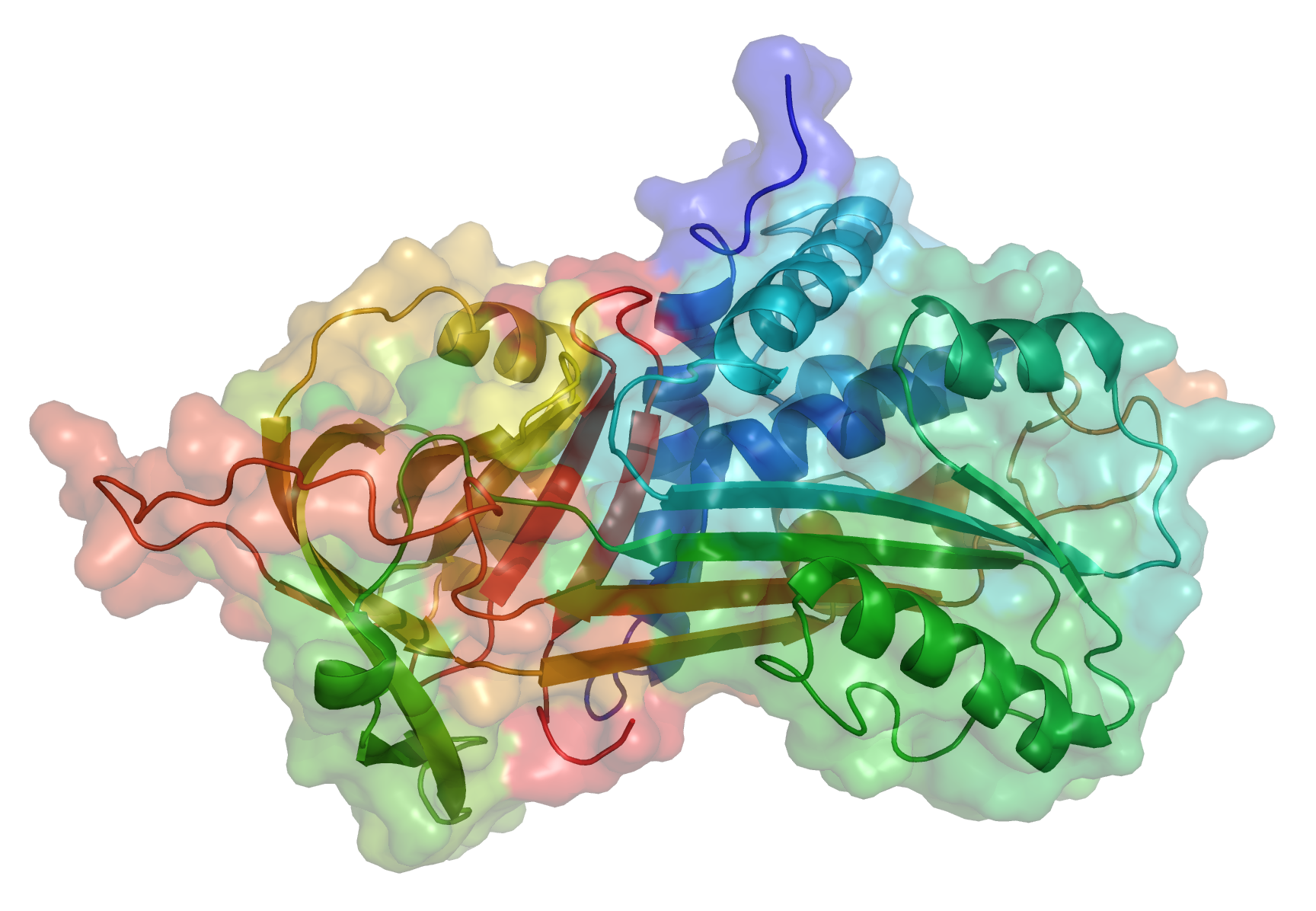
Although it is rare, some people get COPD because of a genetic disorder known as Alpha-1 Antitrypsin Deficiency. It happens when a genetic mutation prevents your body from making enough of a protein called alpha-1 antitrypsin, and it's responsible for about 1-2 percent of cases of COPD.
The alpha-1 antitrypsin protein is vital for protecting your lungs from getting damaged by your body's own enzymes. When you don't have enough of it in your lungs, the enzymes will start breaking down healthy lung tissue, which can cause COPD over time.
People with Alpha-1 (also known as Alphas) can get COPD even if they've never smoked or exposed themselves to other causes of COPD. However, Alphas who smoke are much more likely than non-Alpha smokers to develop COPD.
There are several different genetic mutations that can cause Alpha-1, and some are more likely than others to cause COPD. However, Alphas that do get COPD often develop the disease at a much younger age than people who don't have the genetic disorder.
Fortunately, there is a special treatment for Alphas known as augmentation therapy that can help prevent COPD. By increasing the levels of alpha-1 antitrypsin protein in the lungs, augmentation therapy helps protect their lungs from damage; however, it cannot heal any lung damage that has already been done.
Unfortunately, some people don't even discover they have Alpha-1 until they've already been diagnosed with COPD. To learn more about Alpha-1 Antitrypsin Deficiency, see our comprehensive guide on Alpha-1 here.
Conclusion
Even though the vast majority of COPD cases are caused by smoking, it's important to know that there are many other substances and lifestyle factors that can contribute to the disease. Most of the causes on this list are preventable, and better education and outreach could help prevent many cases of COPD.
If you or a loved one suffers from COPD, you may or may not ever be certain of what caused it. By the time you get COPD later in life, it could be years since your last exposure to the respiratory irritants that led you to develop the disease.
However, the exact cause of COPD is not as important as making healthy choices for yourself and your lungs. Whether or not you have COPD, making an effort to avoid the lung irritants on this list will help you keep your lungs healthy and doing their job efficiently for as long as possible.


.png)



